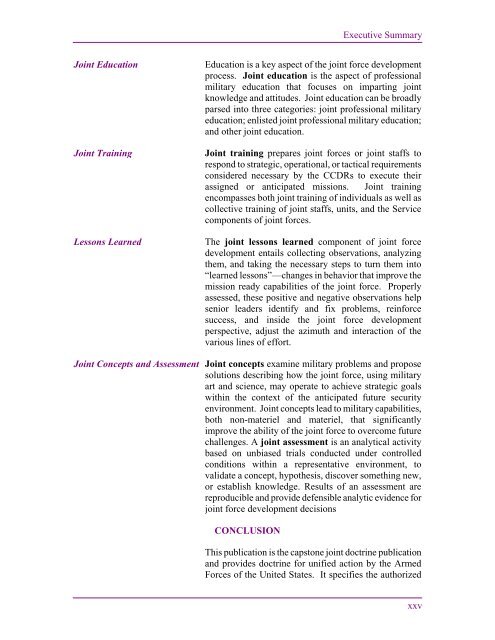JP 1, Doctrine for the Armed Forces of the United States - Defense ...
JP 1, Doctrine for the Armed Forces of the United States - Defense ...
JP 1, Doctrine for the Armed Forces of the United States - Defense ...
Create successful ePaper yourself
Turn your PDF publications into a flip-book with our unique Google optimized e-Paper software.
Executive Summary<br />
Joint Education<br />
Joint Training<br />
Lessons Learned<br />
Education is a key aspect <strong>of</strong> <strong>the</strong> joint <strong>for</strong>ce development<br />
process. Joint education is <strong>the</strong> aspect <strong>of</strong> pr<strong>of</strong>essional<br />
military education that focuses on imparting joint<br />
knowledge and attitudes. Joint education can be broadly<br />
parsed into three categories: joint pr<strong>of</strong>essional military<br />
education; enlisted joint pr<strong>of</strong>essional military education;<br />
and o<strong>the</strong>r joint education.<br />
Joint training prepares joint <strong>for</strong>ces or joint staffs to<br />
respond to strategic, operational, or tactical requirements<br />
considered necessary by <strong>the</strong> CCDRs to execute <strong>the</strong>ir<br />
assigned or anticipated missions. Joint training<br />
encompasses both joint training <strong>of</strong> individuals as well as<br />
collective training <strong>of</strong> joint staffs, units, and <strong>the</strong> Service<br />
components <strong>of</strong> joint <strong>for</strong>ces.<br />
The joint lessons learned component <strong>of</strong> joint <strong>for</strong>ce<br />
development entails collecting observations, analyzing<br />
<strong>the</strong>m, and taking <strong>the</strong> necessary steps to turn <strong>the</strong>m into<br />
“learned lessons”—changes in behavior that improve <strong>the</strong><br />
mission ready capabilities <strong>of</strong> <strong>the</strong> joint <strong>for</strong>ce. Properly<br />
assessed, <strong>the</strong>se positive and negative observations help<br />
senior leaders identify and fix problems, rein<strong>for</strong>ce<br />
success, and inside <strong>the</strong> joint <strong>for</strong>ce development<br />
perspective, adjust <strong>the</strong> azimuth and interaction <strong>of</strong> <strong>the</strong><br />
various lines <strong>of</strong> ef<strong>for</strong>t.<br />
Joint Concepts and Assessment Joint concepts examine military problems and propose<br />
solutions describing how <strong>the</strong> joint <strong>for</strong>ce, using military<br />
art and science, may operate to achieve strategic goals<br />
within <strong>the</strong> context <strong>of</strong> <strong>the</strong> anticipated future security<br />
environment. Joint concepts lead to military capabilities,<br />
both non-materiel and materiel, that significantly<br />
improve <strong>the</strong> ability <strong>of</strong> <strong>the</strong> joint <strong>for</strong>ce to overcome future<br />
challenges. A joint assessment is an analytical activity<br />
based on unbiased trials conducted under controlled<br />
conditions within a representative environment, to<br />
validate a concept, hypo<strong>the</strong>sis, discover something new,<br />
or establish knowledge. Results <strong>of</strong> an assessment are<br />
reproducible and provide defensible analytic evidence <strong>for</strong><br />
joint <strong>for</strong>ce development decisions<br />
CONCLUSION<br />
This publication is <strong>the</strong> capstone joint doctrine publication<br />
and provides doctrine <strong>for</strong> unified action by <strong>the</strong> <strong>Armed</strong><br />
<strong>Forces</strong> <strong>of</strong> <strong>the</strong> <strong>United</strong> <strong>States</strong>. It specifies <strong>the</strong> authorized<br />
xxv

















